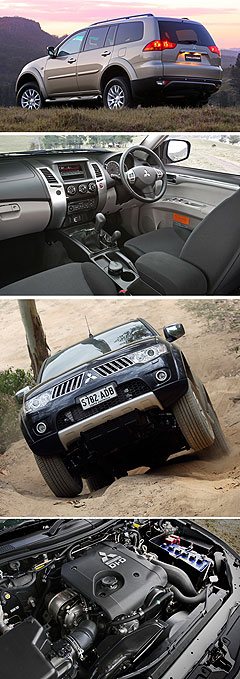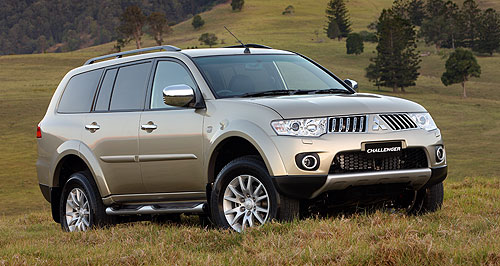Make / Model Search
New models - Mitsubishi - Challenger - 5-dr wagon rangeRugged Mitsubishi Challenger takes on SUV softiesSerious Challenger: Mitsubishi's Triton-based Challenger is still the geniune article in the bush. Mitsubishi sticks with truck chassis and turbo diesel power for new Challenger2 Dec 2009 By PHILIP LORD THE new 2010 Mitsubishi Challenger has arrived in Australia with tough off-road cred, a lone 2.5-litre diesel engine and seven-seat option to take on medium SUV market players such as the Ford Territory, Toyota Kluger, Holden Captiva and Nissan Pathfinder. The PB series Challenger uses increasingly rare elements in the SUV market – a separate chassis and dual-range transmission. Most of its key competitors – medium SUVs that have a similar footprint on the road and are in a similar price bracket, such as Territory and Kluger – use car-like monocoque chassis and single-range transmission. The Challenger is a familiar nameplate in Australia, as the previous model sold here from 1998 to 2007. The PA Challenger was also based on a Triton separate chassis platform, but was a V6 petrol-only in five-seat configuration and with a live rear axle. The medium SUV market that the Challenger will join when it goes on sale on December 7 has declined 11.8 per cent this year. That’s better than the 33.7 per cent loss of the large segment but not as good as the 6.8 per cent drop in compact SUV sales, and 1.3 per cent slip the luxury category.  Mitsubishi has modest expectations for the Challenger, with a monthly sales figure of between 200 and 250 Challengers expected – about half the running rate of Pajero this year and about 20 per cent of the category’s current number-one player, the Kluger. Mitsubishi has modest expectations for the Challenger, with a monthly sales figure of between 200 and 250 Challengers expected – about half the running rate of Pajero this year and about 20 per cent of the category’s current number-one player, the Kluger.While the Challenger sits in the $45k-$58k price bracket, its bigger brother, the Pajero, is around $8k to $14k more expensive at roughly the same equipment level. Even though the cheapest Pajero is only $4k more for the $49,290 GL, it is a basic fleet five-seater model. The Challenger is bit of a melange of ingredients from other models, but 4WD traditionalists may like what Mitsubishi has cooked up. The Challenger takes the Triton’s tough separate chassis with coil spring independent front suspension with three-link live-axle coil sprung rear suspension in place of the Triton’s load-hauling live-axle, leaf-spring arrangement. The wheelbase is shorter than Triton (2800mm versus 3000mm), as well as shorter overall but is slightly taller and wider. At 2041kg to 2110kg, the Challenger is about 100-200kg heavier than a Triton double cab and around 100kg lighter than the Pajero. No independent crash testing has been done, but based on its testing, Mitsubishi claims the Challenger will be capable of achieving four stars. The powertrain is the now-familiar Triton diesel. While Mitsubishi Australia had considered a V6 petrol Challenger, it kept the model range tight by going only with diesel power. This engine, codenamed 4D56HP, is a 2.5-litre common-rail unit that features a variable geometry turbocharger and an intercooler. It develops the same outputs as in Triton, that is, 131kW of power at 4000 rpm and 400Nm of torque at 2000rpm when mated with a manual transmission. With the automatic transmission, torque drops to 350Nm at 1800rpm. The 2.5 manual achieves an average fuel consumption of 8.3L/100km and the automatic 9.8L/100km. The engine is supplied by a 70-litre fuel tank. The manual transmission offered only in LS five-seater configuration is a five-speed unit and the automatic is the five-speed INVECS II Smart Logic transmission with Sports Mode. Both transmissions are also used in Triton. The dual-range Super Select full-time/part-time 4WD system is standard in Challenger, and allows you to select rear-wheel drive to save fuel or full-time 4WD for paved roads, benefiting traction and safety. For slippery roads, the centre diff can be locked in high range and for slow off-road work, low-range gearing and a rear differential lock are standard across the range. Steering is power-assisted rack and pinion, with a turning circle of 11.2 metres. Ventilated disc brakes are fitted front and rear and the Challenger has a drum-in-disc handbrake. Safety is covered off with MATT (Mitsubishi’s All Terrain Technology system) which includes Active Stability and Traction Control (ASTC), Multi-mode ABS with EBD. Challenger also has driver and passenger front and side SRS airbags and curtain SRS airbags on all models in the range. Five models in two trim grades are offered, with entry-level LS and premium XLS. The LS is available as a five-seat manual or automatic and as a seven-seat automatic. The XLS is auto-only but offers the choice of five-seater or seven-seater models. Standard equipment on the LS models includes climate-control air-conditioning, steering wheel-mounted cruise control and audio controls, power windows with driver’s one-touch function, remote keyless central locking, single CD player with six speakers, leather steering wheel, gear shift, park brake and transfer lever, colour centre display and an audio jack for MP3 player connection, 17-inch alloy wheels (with a full sized alloy spare), rear differential lock, side steps, roof rails and chrome exterior door handles and mirrors. The LS seven-seat version adds third-row seating with 50/50 split, manual rear seat air-conditioning controls and under-floor storage area. Automatic transmission is standard. The XLS five-seater adds leather seats, power driver’s seat, wood-trim console and centre panel, the premium audio Power Sound System with eight speakers, Mitsubishi Multi Communication System (MMCS) with satellite navigation, reversing camera and video jack, hands-free Bluetooth, cargo blind and cargo room net, chrome grille, colour keyed side protection mouldings and privacy glass. The XLS also features fog lights, headlight washers and rear parking sensors. The Challenger XLS with seven-seat option features the third row seating with 50/50 split, manual rear seat air-conditioning controls and under-floor storage area. Colours available for Challenger include the non-metallic White Solid and optional metallic Charcoal Metallic, Cool Silver Metallic, Platoon Pearlescent, Terra Rossa Metallic, Champagne Metallic, Deep Blue Pearlescent and Black Pearlescent.
 Quick testsRead more7th of August 2009  Mitsubishi hits accelerator on Challenger debutAbout-face by Mitsubishi on Challenger launch delay as market picks up16th of July 2009  GFC delays Mitsubishi’s ChallengerMitsubishi pushes back the launch of its new-generation Challenger SUV until 2010All new modelsMotor industry news |
|
||||||||||||




 Alfa Romeo
Alfa Romeo Abarth
Abarth Audi
Audi Aston Martin
Aston Martin BMW
BMW Bentley
Bentley Ferrari
Ferrari Chevrolet
Chevrolet Ford
Ford Fiat
Fiat GWM
GWM Foton
Foton Hyundai
Hyundai Honda
Honda Jaguar
Jaguar Isuzu
Isuzu Kia
Kia Jeep
Jeep Land Rover
Land Rover Lamborghini
Lamborghini Maserati
Maserati Lexus
Lexus McLaren
McLaren Mazda
Mazda Mercedes-Benz
Mercedes-Benz Mitsubishi
Mitsubishi Mini
Mini Peugeot
Peugeot Nissan
Nissan Ram
Ram Porsche
Porsche Rolls-Royce
Rolls-Royce Smart
Smart Skoda
Skoda Suzuki
Suzuki Subaru
Subaru Toyota
Toyota Tesla
Tesla Volvo
Volvo Zeekr
Zeekr







Facebook Twitter Instagram